Features
Reflections on 2 Winnipeg synagogues: While one is being radically transformed, one is just trying to stave off closure
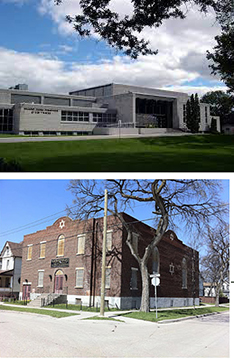
By BERNIE BELLAN My reports on this website about wo different Winnipeg synagogues and how they’re both attempting to change with the times might serve as a reminder to readers how much of a vital role synagogues used to play in the lives of Winnipeg Jews.
In December 2021 I wrote about a proposal to repurpose the Ashkenazie synagogue into a synagogue/museum. Writing that story got me to thinking about the history of Winnipeg synagogues in general, so I also wrote an article in which I listed all the synagogues that ever existed north of the CPR tracks.
There were 34 of them! (You can read both stories in our Dec. 8, 2021 issue. Simply enter the words Dec. 8, 2021 in our “search archive” searchbox.)
Now, while various synagogues either completely folded or merged with other synagogues over the years, there can be no doubt that it was the synagogue that played the central role in the lives of most Jewish Winnipeggers for years in this city.
I don’t think I have to tell you that the situation is completely different these days. There are very few synagogues left in Winnipeg and what few synagogues we do have are clamouring for members.
There’s nothing particularly surprising about that, given that churches, as well, have seen a huge decrease in popularity in recent years. (Mosques, on the other hand, are showing robust growth – in Winnipeg, as well as other areas in Canada.)
We’ve recently seen the relocation of the Etz Chayim congregation to new south end quarters and, while the assessment of most members with whom I’ve talked is that it’s a very nice building, it doesn’t quite have the feel of a synagogue.
As for the Shaarey Zedek, it’s a huge unknown whether the renovation project that is slated to be completed in August (according to congregation president Neil Duboff, but perhaps a little bit later, as there are always unforeseen delays in an undertaking as massive as the complete overhaul of Winnipeg’s largest synagogue entails), will lead to a rush of new members joining the Shaarey Zedek congregation. Or, to be more realistic: Will it lead to many of those who have abandoned the Shaarey Zedek, especially since Covid, rejoining?
The demographics of Winnipeg’s Jewish community don’t portend a large increase in synagogue membership going forward. Our community isn’t growing and, by and large, new arrivals to Winnipeg’s Jewish community haven’t shown much interest in becoming synagogue members. (I do note that the Etz Chayim has been somewhat successful in attracting new immigrant families, but the numbers are relatively small as a proportion of our overall Jewish community.)
As I note in my article about the Shaarey Zedek, one would expect that there will be an initial flurry of interest in seeing what the renovated synagogue is like – and with a gorgeous new event centre it is likely to become the go-to venue once again for life cycle events, such as weddings and bar or bat mitzvahs, at least for the first year. Many of those celebrations have been occurring outside of a synagogue setting, however, and it’s hard to see how, other than the Shaarey Zedek becoming the “in” venue for a period of time, that initial rush of event bookings that are likely to occur there will continue in the long run. There is just too much interest in trying to make a life cycle event unique that will work against any one venue becoming the favoured destination for more than a short period of time, especially as people compete with one another for inventiveness.
But, what of the rather interesting proposal I’ve also written about in my article on the home page here, about the proposal to turn the Ashkenazie synagogue into a combination synagogue/museum?
In theory, it’s a great idea – but realistically, how many people are going to be willing to head down to a part of town that is, to put it euphemistically, not as safe as one might like? I’ve generally shied away from dwelling on how scary whole parts of Winnipeg are now in which to venture forth. I’ll leave it for the Winnipeg Free Press to scare the bejesus out of most of us with its daily reports of break-ins, stabbings, assaults – and all too frequent murders, in this lovely city. I don’t need to add to your fear – unless you’re like many readers who have informed me they simply stopped taking the Free Press – and shy away completely from established media sources. (I’m always curious which news sources those readers now rely upon? I hope that it’s not simply the internet because, for all its faults, the Free Press is still by far the best news source in this town.)
I recall going on a Jane’s Walk a few years back, led by Zach Fleisher, that was made up of visits to some north end hallmarks that once played – and in some cases, still do play vital roles within our Jewish community.
It began at the site of the old CPR train station, which is where so many of our ancestors first arrived when they came to Winnipeg. We then proceeded to Joe Zuken Park in Point Douglas (which has no particular significance for the Jewish community other than it is located in an area that was once teeming with new Jewish arrivals), then on to the Chesed Shel Emes, Gunn’s Bakery, the Ashkenazie synagogue, and finally the former Talmud Torah on Charles Street.

Ever since then I’ve wanted to revisit that particular walk. At each point along the way we learned so much about our community’s history. And, as someone who hadn’t often been back to the Ashkenazie since my childhood, I marvelled at how beautiful it still was. It was because of that visit to the Ashkenzie, where the late Saul Spitz gave us such an interesting description of the synagogue’s history, that I would love to see Dr. Yosel Minuk’s imaginative proposal for redeveloping that grand old building at least be given the opportunity to move beyond total dismissal by the powers that be. All that it would take is a few former members of the Ashkenazie who may have moved elsewhere (or perhaps their children or grandchildren), and who might have the means to help in the synagogue’s redevelopment brought to life for that proposal to have a chance of succeeding.
And isn’t that how so many projects within our Jewish community have attained their goals? Perhaps the most vivid example in recent memory was BB Camp’s capital campaign, which succeeded in raising over $6 million five and a half years ago – largely as a result of BB Camp alumni from all over North America contributing to the cause.
While the Ashkenazie might have relatively very few former members left around the world, I know that when former Winnipeggers return to Winnipeg for a visit, very often they check out their former haunts in the North End. There is still a huge sentimental attachment to the North End on the part of so many ex-Winnipeggers (which they have often passed on to their children and grandchildren). Perhaps if they were to realize how perilous the situation is for the Ashkenazie they might step up to help preserve that grand old edifice. After all – they’ve lost Kelekis Restaurant and the North End Sals. What other shrines do they have left to visit on the way to check out the homes where they (or their parents) grew up?
One final note – and this has to do with Israel’s war in Gaza – a recent article in Haaretz delves into Netanyahu’s long, complicated, and “symbiotic” relationship with Hamas, according to the author of a new book about that relationship. (In one of the most surprising aspects of that article, it says that Yahya Sinwar, Israel’s arch enemy and the one man almost every Israeli would like to see dead, sent a note to Netanyahu in 2022 “that read ‘calculated risk’ – in Hebrew.” By the way, the author of the book doesn’t pretend to understand what exactly Sinwar meant by that cryptic note.)
One other part of that article, however, does more to explain how so many Israelis who might have considered themselves leftists or centrists prior to October 7 have now swung so far in the opposite direction to the point perhaps that we in the diaspora might now fully appreciate how hell bent so many Israelis are on wiping out Hamas.
The author of the book referred to in the Haaretz article is someone by the name of Adam Raz. According to information given about him at the beginning of the article, Raz is determinedly leftist in his political viewpoint – and so, apparently, was his mother – until October 7.
Here’s how Raz describes an encounter he had with his mother the day of October 7: “The day of the horrific events of October 7,Israeli political historian and author Adam Raz had a big fight with his mother. A longtime leftist and devoted Meretz voter, she surprised him with her harsh reaction. ‘She said: “They should pour gasoline all over Gaza and blow it up,” ‘ recounts Raz, whose work deals with political theory, the Israeli-Arab conflict and the nuclear arms race. ‘I realized that I needed to delve into the psyche that made even left-wing Israelis think this way.’
I wonder, more than seven months after the October 7 massacre, how many Israelis still hold that attitude? I ask that, not because I think I know the answer, but because I honestly don’t – yet it’s never really explored in all the analyses of what’s happening in Israel, is it? And it is crucial to understanding why so many Israelis say “to hell with the rest of the world. If we have to, we’ll go it alone.”
Features
Japanese Straightening/Hair Rebonding at SETS on Corydon

Japanese Straightening is a hair straightening process invented in Japan that has swept America.

Features
History of the Winnipeg Beach Synagogue: 1950-2025
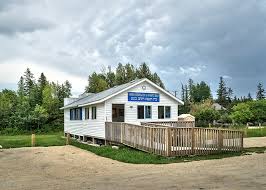
By BERNIE BELLAN The history of the Winnipeg Beach Synagogue is a fascinating one. We have had several articles over the years about the synagogue in The Jewish Post & News.
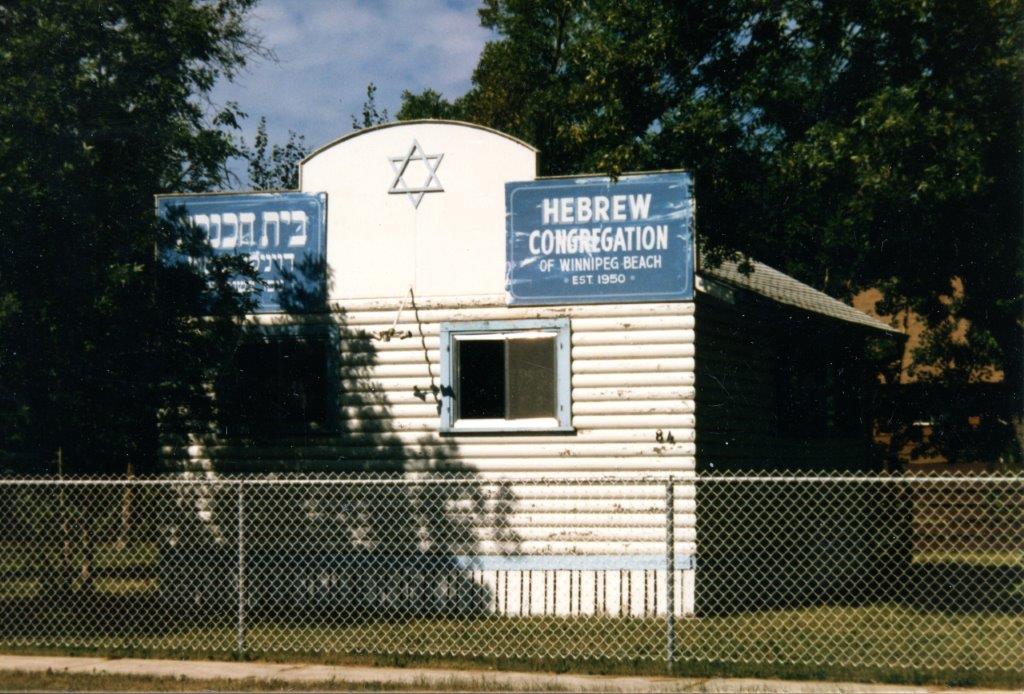
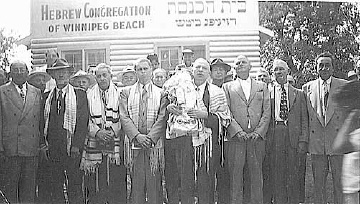
In June 2010 I wrote an article for The Jewish Post & News upon the 60th anniversary of the synagogue’s opening. Here are the opening paragraphs from that article:
“Sixty years ago a group of Winnipeg Beach vacationers decided that what their vacation area lacked was a synagogue. As it happened, a log cabin one-room schoolhouse in the Beausejour area happened to be available.
“In due course, the log cabin was relocated to the corner of Hazel and Grove in Winnipeg Beach, where it stayed for 48 years.”
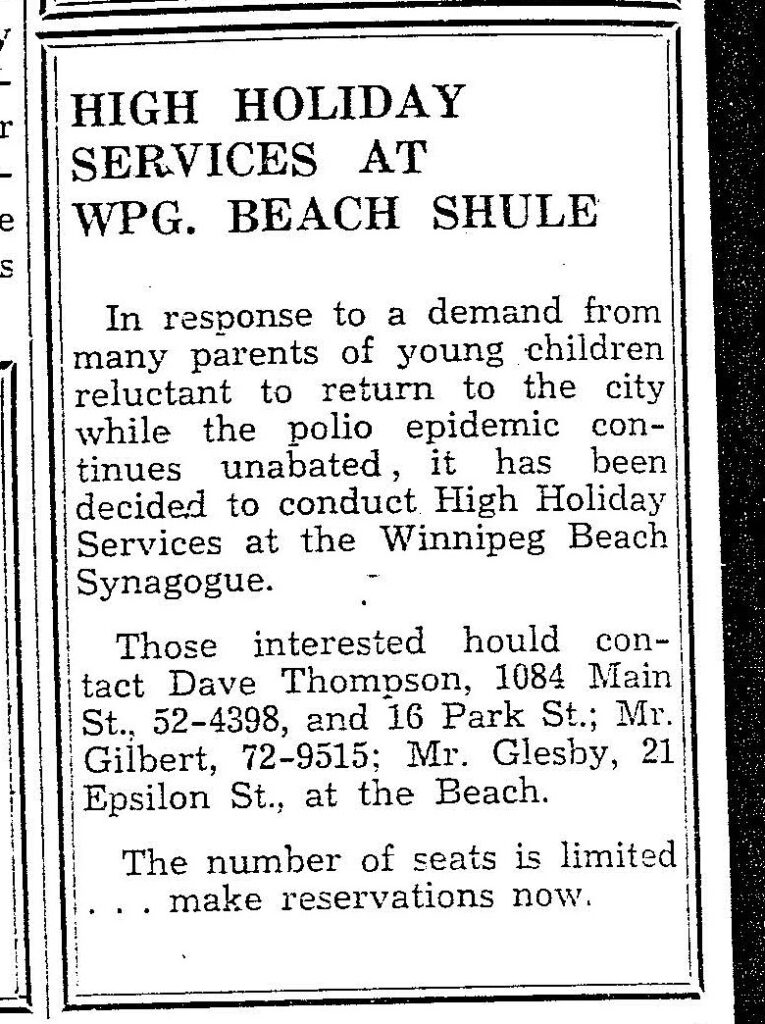
In December 1994 my late brother, Matt, wrote a story about the spraying of antisemitic grafitti on the synagogue which, at that time, was still situated at its original location on the corner of Hazel and Grove in the town of Winnipeg Beach:
“Two 16-year-olds spraypainted slogans like ‘Die Jews,’ ‘I’ll kill you Jews,’ and other grafitti in big letters on the beach synagogue.
“Jim Mosher, a news reporter for the Interlake Spectator in Gimli, said last Halloween’s vandalism against the synagogue wasn’t the first. In the late 1980s, he claimed, it was spraypainted with swastikas.
“Jack Markson, a longtime member of the Winnipeg Beach Synagogue, last week also said he could remember finding anti-Semitic grafitti spraypainted on the synagogue ‘a few years ago,’ and at least twice in the 1970s, when the cottage season was over.”
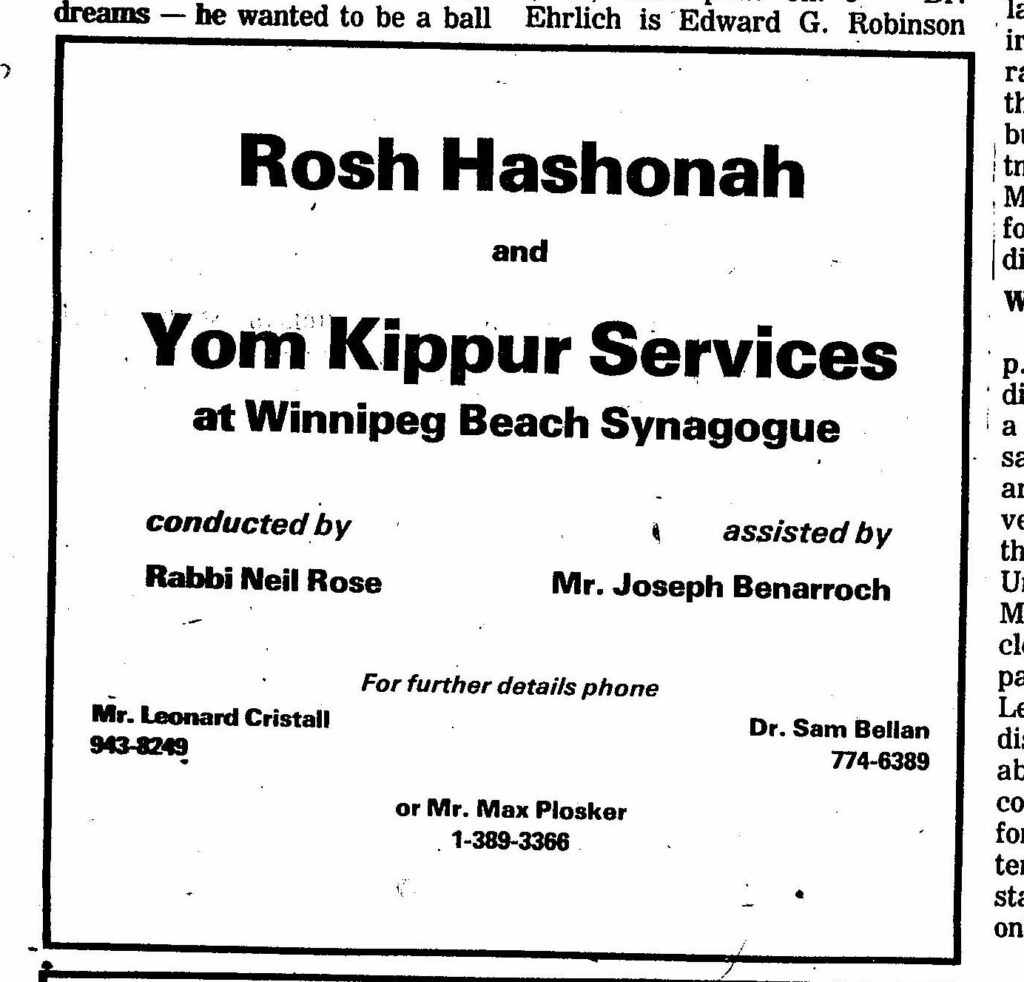
My 2010 article continued: “In 1998 the Town of Winnipeg Beach informed the members of the synagogue that the building would have to be hooked up to the town’s sewer and water system. Rather than incur the cost of $3-4,000, which was thought to be ‘prohibitive,’ according to longtime beach synagogue attendee Laurie Mainster, synagogue goers looked elsewhere for a solution.
“As a result, the board of Camp Massad was approached and asked whether the synagogue might be relocated there, with the understanding that the synagogue would be made available to the camp at any time other than what were then Friday evening and Saturday morning services.
“Over the years the ‘beach synagogue’ had come to be a very popular meeting place for summertime residents of Winnipeg Beach and Gimli. In fact, for years minyans were held twice daily, in addition to regular Saturday morning services. Of course, in those years Winnipeg Beach was also home to a kosher butcher shop.
“While the little synagogue, which measured only 18 x 24 feet, has gone through several transformations, including the move to Camp Massad, and the opening up to egalitarian services in 2007 (The move to egalitarian services was as much a practical necessity as it was a nod to the equality of women – the only Kohen present at the time was a woman!), it has always remained cramped at the best of times.
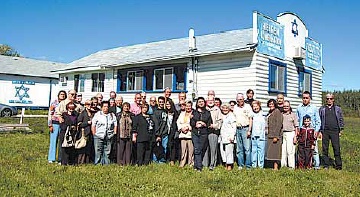
“In recent years the synagogue has seen the addition of a window airconditioner (although to benefit from it, you really have to be sitting just a few feet away), as well as a fridge that allows synagogue attendees to enjoy a regular Saturday morning Kiddush meal following the service.
“According to Laurie Mainster, the Saturday morning service has continued to be popular, even though many of the attendees now drive in from Winnipeg, as they have sold the cottages they once maintained.
“On the other hand, one of the side benefits to being located on Camp Massad’s grounds has been an infusion of young blood from among the camp counsellors.
“Since there is no longer a rabbi available to conduct services (Rabbi Weizman did lead services for years while he had a cottage at the beach), those in attendance now take turns leading the services themselves.
“Anyone may attend services and, while there are no dues collected, donations are welcome. (Donations should be made to the Jewish Foundation of Manitoba, with donors asked to specify that their donations are to be directed to the beach synagogue.)
“Mainster also says that the beach synagogue is now undergoing an expansion, which will be its first in 60 years. An entirely new space measuring 16 x 18 feet is being added – one that will allow for a real Kiddush area. (Until now, a table has been set up in the back of the synagogue and synagogue goers would help themselves to the buffet that is set up each Saturday during the summer. While pleasant enough, it will certainly be more comfortable to have an actual area set aside for the Saturday afternoon after service lunch.)
“As for dress, longtime attendee Abe Borzykowski (in an article written by Sharon Chisvin for the Free Press in 2007) remarked that ‘I don’t think there are many synagogues where people can attend in shorts, T-shirts and sandals and not feel out of place.’ “

As mentioned in that 2010 article, the beach synagogue at that time was about to undergo an extensive remodelling. Here is an article from a January 2011 issue that describes that remodelling process. The article was written by Bernie Sucharov, who has been a longtime member of the beach synagogue:
“The Hebrew Congregation of Winnipeg Beach made a major change to the synagogue this past summer. With the help of many volunteers, Joel Margolese being the project manager, the synagogue was expanded and an addition was built to handle the overflow crowds, as well as to add more space for the kiddush following services.
“The volunteers spent many Sundays during the summer months building the addition. Bad weather caused many delays, but finally the addition was completed one week before the official summer opening.
“The volunteers were: Joel Margolese, Gordon Steindel, Sheldon Koslovsky, Viktor Lewin, Harvey Zabenskie, Nestor Wowryk, Kevin Wowryk, Victor Spigelman, Jerry Pritchard, and David Bloomfield.
“On Sunday, June 25, 2010 a special ceremony was held to affix a mezzuzah to the front entrance door. Gordon Steindel had the honour of affixing the mezzuzah, which was donated by Sid Bercovich and Clarice Silver.
“Refreshments and food for the day were prepared by Phyllis Spigelman, also known as our catering manager. Throughout the summer, Phyllis, Lenore Kagan and other friends prepared the food for our kiddush.
“A sound system was donated by Arch and Brenda Honigman in memory of their father, Sam Honigman z”l. “The system was installed by Joel Margolese and Stevan Sucharov. This will allow the overflow crowd to hear the service in the new addition.
“There were also generous donations of 50 chumashim and an air conditioner. The chumashim were donated by Gwen, Sheldon and Mark Koslovsky. The air conditioner in the new addition was donated by Joel and Linda Margolese.
“The official opening of the synagogue for the summer took place on July 3, 2010. We had an overflow crowd of 70+ people.”

Since that 2010 major addition to the synagogue, it has also added a wheelchair ramp (although I’ve been unable to ascertain exactly when the ramp was built). Also, the synagogue also has its own outdoor privy now. (Attendees used to have to use facilities in Camp Massad.)
And, as already noted in article previously posted to this site (and which you can read at Beach Synagogue about to celebrate 75th anniversary), in recognition of that occasion, on August 2nd members of the synagogue will be holding a 75th anniversary celebration.
As part of the celebration anyone who is a descendant or relative of any of the original members of the first executive committee is invited to attend the synagogue that morning.
If you are a relative please contact Abe Borzykowski at wpgbeachshule@shaw.ca or aborzykowski@shaw.ca to let Abe know you might be attending.
Features
Kinzey Posen: CBC Winnipeg’s former “go-to guy”

By GERRY POSNER If former Winnipegger Lawrence Wall was the CBC go-to guy in Ottawa, CBC Winnipeg had its own version of a go-to guy for many years with none other than the very well known Kinzey Posen. Of course, many readers will recognize that name from his career with Finjan, the Klezmer group so famous across Canada and beyond. It has been written about Posen and his wife Shayla Fink that they have been involved in music since they got out of diapers. And, as an aside, their love and ability in music has now been transmitted to the next generation as in their son, Ariel Posen (but that’s another story).
Kinzey Posen (not to be confused with Posner, or maybe we are to be confused, but who knows for sure?), was a graduate of Peretz School, having attended there from nursery right until Grade 7, graduating in1966. That was followed by Edmund Partridge and West Kildonan Collegiate. Musically, he was in large part self taught. However, he did have some teachers along the way. After moving to Vancouver – from 1974-78, he had the chance to study acoustic classical bass with a member of the Vancouver Symphony Orchestra. When Kinzey lived in Vancouver, he also worked as a jazz musician.
Upon returning to Winnipeg, Kinzey enrolled as a mature student at the University of Winnipeg, where he obtained a Bachelor of Urban Studies degree. Although the degree was in no way connected to the career that followed, his attending the University of Winnipeg was critical to his connecting with the CBC. Why? you ask. Kinzey had a position after graduation working for the Institute of Urban Studies. While there, he met someone who invited him to work for the Department of Continuing Education as one of their program directors. At the time the Department of Continuing Education was located at 491 Portage Avenue, which was also known as the TJ Rice Building. The CBC also leased some space in the same building. According to Kinzey, the CBC part of the building “included HR, different shows and other support offices. Continuing Education was located in the basement and main floor and that’s where I worked.”
KInzey had long had an interest in the CBC, which made the fact that the CBC had some offices in the same building where he was working serendipitous. That Kinzey might be interested in visiting the CBC was not an accident. As a young boy he had a nightly connection to CBC, as it was his ritual to listen to CBC Radio (as well as all sorts of other radio stations across the USA) on his transistor radio every night in bed. He became enamoured of one particular CBC host, Bill Guest, so that when going to sleep, he imagined that he was Guest doing interviews with imaginary guests. That dream of working for CBC became a reality when he had a chance to do a one week gig with Jack Farr’s network program.
Kinzey took a week off from his Continuing Education job and spent five days at the CBC. That week was a training session for Posen, as he had to create ideas, research, pre-interview, write the script, and set up the studio for Farr’s interview. He was almost in his dream job – although not quite – since it was only for one week. His opportunity, however, came in 1988, when he was offered a one-year term as a production assistant – the lowest guy on the ladder, for a show called “ Simply Folk,” with the late Mitch Podolak as the host. Although he was indeed at the bottom as far as those working on the show were concerned, he took a chance and gave his notice to the U of W. The rest is history. In his new job, Kinzey learned how to become a producer. Lucky for him, at the end of the year, when the person he replaced was supposed to come back, she never returned (just like the song, “MTA,” by the Kingston Trio). At that point, Kinzey was hired full time at the CBC.
Kinzey was a fixture at the CBC for 27 years. During those years, Kinzey had the chance to work with Ross Porter, a respected former CBC host and producer, also with Karen Sanders – on the “Afternoon Edition.” One aspect of Kinzey’s job on the Afternoon Edition was to come up with ideas, mix sound effects, arrange interviews and music, to create a two-hour radio experience. In addition, he covered jazz and folk festivals and, as a result, was exposed to some of the best musicians in the world. With Ross Porter in the 1990s, he worked on a network jazz show called “ After Hours,” which was on from 8-10 PM five nights a week. Kinzey was involved with writing the scripts, picking the music, and recording the shows, as well as editing them and then presenting them to the network for playback.
Of course, over his career, Kinzey had many memorable moments. He told me about one of them. The story revolved around the National Jazz Awards one year in particular. The awards were to be broadcasted after the National News which, in those days, began much earlier in the evening, and were over by 8:00 pm. The legendary Oscar Peterson was lined up to play a half hour set at the awards, starting at 7:30. But, as Kinzey told me, Oscar Peterson had a “hate on” for the CBC ecause one of his recorded performances was wrongly edited and he refused to appear on CBC under any circumstances. As the time neared 8:05 PM, which was when the CBC was to begin its broadcast of the jazz awards, it became apparent that Oscar was not going to finish on time. As the producer of the awards show, Kinzey was tasked with telling Oscar Peterson to wrap it up and get off the stage. There was Kinzey Posen, a huge fan of Oscar Peterson, now faced with the prospect of telling Oscar – while he was still playing – with 500 people in the audience, to stop and get off the stage. Not often was or is Kinzey Posen frozen, but that was one such moment. There was one loud “Baruch Hashem” from Kinzey when Oscar completed his set literally just in time.
Clearly, Kinzey was part of a very successful run with After Hours as it was on the air for 14 years. It was easily one of the most popular shows on CBC Radio 2, and a winner of several broadcasting awards. Kinzey also played a major role in producing a two part documentary about legendary guitarist Lenny Breau.
When After Hours ended, Posen became one of the contributing producers to Canada Live and specialized in producing live radio specials for the network, such as the Junos, for CBC Radio One and Two. Needless to say, his career planted Posen in the world of some top notch musicians, including his time spent working with Robert Plant (Led Zeppelin), Dave Brubeck, Randy Bachman, Chantal Kreviazuk and a list of prominent names in the Canadian, American and European music spheres. Locally, the CBC came to refer to Kinzey as the Jewish expert. I would add music expert to that title.
After his 27 year run at the CBC – and before he fully retired, Kinzey went on to work for the Rady JCC as a program director for a year and a half. Of course, to say that Kinzey Posen is retired is a major contradiction in terms. You really can’t keep him down and he has his hand in a variety of programs and projects – most of which he remains silent about, as is his style.
When I realized the full depth and talent of Kinzey Posen, I quickly concluded that he must certainly be related to me. Even if he isn’t, I now tell people he is.
